Victorian jewelry design spanned three distinct periods (1837-1901), each with unique techniques. You’ll find Romantic era pieces featuring cannetille wirework and sentimental motifs, Grand period items showcasing repoussé and mourning symbolism, and Aesthetic period jewelry employing advanced enameling and filigree work. Craftsmen combined traditional methods with innovations in gemstone cutting and setting. Each piece tells a story through its materials, symbolism, and the skilled hands that created it.
The Three Distinct Phases of Victorian Jewelry Craftsmanship

Victorian jewelry evolved through three distinct periods, each with its own signature style and craftsmanship techniques.
The Romantic period (1837-1860) featured sentimental designs with hearts and flowers, utilizing repoussé and intricate cannetille wire work to create delicate pieces.
During the Grand period (1860-1885), jewelry techniques shifted toward mourning pieces, with artisans mastering engraving and niello work to embellish jet and onyx materials.
These darker pieces reflected the era’s fascination with memorializing loved ones.
The Aesthetic period (1885-1901) closed the Victorian Era with a celebration of beauty through advanced techniques.
You’ll recognize these pieces by their elaborate enameling and filigree work, showcasing the period’s emphasis on artistic expression over mere utility.
Gold Working Techniques in Early Victorian Design
When examining Early Victorian jewelry, you’ll find Cannetille wirework standing out with its embroidery-like appearance, where craftsmen twisted fine gold wires into intricate lace patterns.
Alongside this delicate technique, the repoussé method transformed flat gold surfaces into dimensional designs through precise hammering from the reverse side.
These gold working techniques flourished despite limited gold availability before the California Gold Rush, highlighting the ingenuity of Victorian artisans who created elaborate pieces even with material constraints.
Cannetille Wirework Artistry
Filigree’s delicate cousin, cannetille wirework emerged as one of the most distinctive gold techniques in Early Victorian jewelry design (1837-1860).
You’ll find this technique characterized by twisted and coiled fine gold wire arranged to create lace-like patterns that mimic embroidery. During the Romantic Period, artisans crafted these intricate designs into lightweight yet ornate brooches, earrings, and pendants.
Victorian jewelry featuring cannetille wirework often showcased nature-inspired motifs—flowers and foliage that added three-dimensional complexity through careful wire arrangement.
Craftsmen soldered these delicate gold elements securely to jewelry bases, creating pieces that were both substantial in appearance yet comfortable to wear.
This technique’s popularity coincided with a broader Victorian fascination with historical styles, making cannetille work highly sought after for its blend of exquisite craftsmanship and sentimental appeal.
Repoussé Hammering Methods
Three fundamental techniques defined Early Victorian metalwork, with repoussé hammering standing as perhaps the most dramatic.
You’ll recognize this method by its distinctive raised designs, created by hammering metal sheets from the reverse side. During the Victorian Era, artisans combined repoussé with chasing to refine surface details, producing jewelry with exceptional depth and texture.
The technique perfectly captured the sentimental themes of the Romantic period. Intricate floral patterns and scrollwork emerged from 18k gold sheets, though lower karats were common before the California Gold Rush.
The resulting pieces showcased the era’s romantic spirit through their dimensional quality and elaborate detailing.
Today’s collectors prize these hammered treasures for their craftsmanship and emotional resonance—tangible connections to an age when jewelry spoke the language of love and nature.
The Art of Repoussé and Cannetille Wire Work
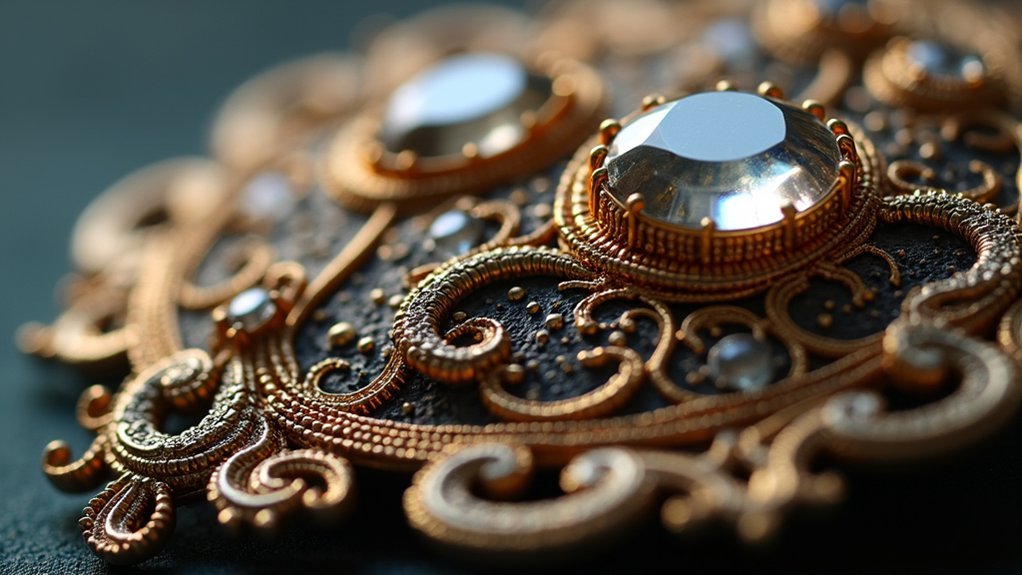
Masterpieces of Victorian jewelry often emerged through the meticulous application of repoussé and cannetille wire work techniques.
When you examine these pieces, you’ll notice how artisans hammered metal sheets from behind to create three-dimensional repoussé designs that captured the romantic Victorian ideals.
The addition of cannetille brought these works to life, as jewelers twisted fine wires into delicate, embroidery-like patterns that enhanced each piece’s elegance.
You’ll find these techniques frequently combined to showcase nature-inspired and historical motifs, with multiple layers creating depth and visual interest.
This combination of craftsmanship didn’t just demonstrate artistic skill—it highlighted the luxurious materials used.
The resulting Victorian jewelry pieces featured complex designs where gold and gemstones were elevated by the intricate texturing that only repoussé and cannetille could achieve.
Symbolism and Meaning in Victorian Jewelry Motifs
Victorian jewelry transcended mere adornment to become meaningful tokens of devotion, with motifs like hearts, flowers, and snakes expressing affection, love, and eternity.
You’ll find these sentimental designs reflected the era’s fascination with romantic communication, particularly in acrostic jewelry where gemstones spelled out endearing messages like “DEAREST.”
The profound Victorian relationship with loss manifested in elaborate mourning pieces featuring weeping willows, urns, and even the deceased’s hair—tangible connections to loved ones that comforted the bereaved during prescribed mourning periods.
Tokens of Devotion
While modern jewelry often serves primarily as decoration, the intricate pieces of the Victorian era told stories of love, loss, and devotion through carefully chosen symbols and motifs.
You’d find hearts, flowers, and intertwined designs adorning sentimental motifs that symbolized the romantic bonds between couples.
Mourning jewelry reflected Victorians’ approach to grief, incorporating weeping willows and urns to commemorate lost loved ones.
The era’s fascination with eternal love manifested in snake imagery, particularly in rings that represented fidelity and unending devotion.
For those seeking subtlety, acrostic jewelry arranged gemstones to spell meaningful words, allowing secret messages to be worn openly.
Even floral designs carried specific meanings in this complex language of accessories, where every element served as a token of the wearer’s deepest emotions.
Mourning Through Adornment
Grief transformed into tangible remembrance became an art form during the 19th century, with mourning jewelry serving as personal memorials worn close to the heart.
During the Victorian era, you’d find these somber pieces crafted from jet, onyx, and gutta-percha—materials as dark as the emotion they represented.
Your mourning jewellery might feature weeping willows, urns, or skulls, powerful symbols reflecting mortality and the afterlife.
The most intimate personal touch came through incorporating the deceased’s actual hair within lockets and brooches. Acrostic designs cleverly arranged gemstones to spell meaningful messages of love and loss.
These ornate accessories weren’t merely fashion statements but culturally sanctioned expressions of grief, allowing you to carry memories of loved ones wherever you went, elegantly transforming profound loss into wearable art.
Gemstone Cutting and Setting Innovations (1837-1901)
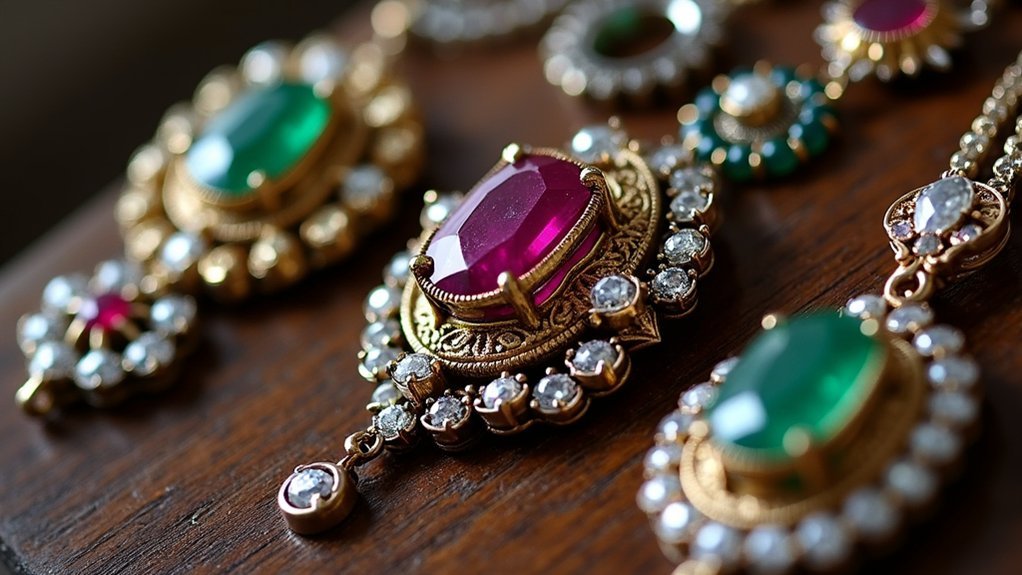
As Queen Victoria ascended the throne in 1837, innovative gemstone cutting techniques were already transforming the jewelry landscape.
During the Victorian era, you’d find stones cut in distinctive styles like the Rose Cut with its flat base and faceted dome, or the Old Mine Cut with larger facets that maximized a diamond’s natural brilliance.
Jewelers embraced claw-like prongs and collet settings that exposed gemstones to more light, enhancing their sparkle.
The period’s intricate designs often featured garnets, opals, and diamonds arranged in creative patterns.
You’d see these gems complemented by elaborate techniques like enameling and cannetille wire work.
Perhaps most charming was the trend of acrostic jewelry, where gemstones were arranged to spell meaningful words—combining cutting innovation with sentimental expression.
The Rise of Mourning Jewelry and Memorial Pieces
You’ll notice that jet jewelry, with its deep lustrous black appearance, became the quintessential material for Victorian mourning pieces due to its symbolic connection to darkness and grief.
The practice of incorporating a loved one’s hair into memorial jewelry allowed Victorians to keep the deceased physically close, with intricate woven hair designs encased in lockets, rings, and brooches.
These personal relics weren’t merely decorative but served as tangible connections to those who’d passed, often worn prominently as public expressions of both loss and enduring attachment.
Jet’s Symbolic Power
Transformation through tragedy defined Victorian mourning culture, particularly in the domain of jewelry design. When you examine authentic Victorian mourning jewelry, you’ll notice jet’s dominance as the material of choice. This lustrous black lignite became especially prominent after Prince Albert’s death in 1861, when Queen Victoria’s grief set the standard for society’s expression of loss.
You’ll find jet pieces showcase exceptional craftsmanship through intricate carvings of symbolic motifs—weeping willows and urns that represented sorrow and remembrance. Many pieces were further personalized with the deceased’s hair, creating tangible connections to loved ones.
Jewelers often enhanced jet’s somber beauty with gold or silver accents, balancing aesthetic appeal with respectful commemoration. Today, these pieces remain coveted collectibles, monuments to the Victorian era’s reverence for both grief and artistic expression.
Hair Art Memorials
Intimacy defined Victorian hair art memorials in ways other mourning traditions couldn’t match. You’d find a deceased loved one’s human hair intricately woven into jewelry pieces worn close to the heart, creating a tangible connection between the living and departed.
| Technique | Materials | Significance |
|---|---|---|
| Braiding | Human hair, gold frames | Eternal bond |
| Weaving | Hair, glass settings | Preserved memory |
| Setting | Jet, onyx, hair | Love beyond death |
Hair jewelry became the ultimate expression of Victorian sentimentality, with locks carefully arranged into hearts, flowers, and other meaningful motifs. Unlike other mourning jewelry featuring dark materials like jet, these personal keepsakes offered sentimental significance beyond symbolism—they contained the actual essence of the departed, transforming grief into wearable art that honored love’s endurance even after death.
Archaeological Revival Influences on Victorian Design
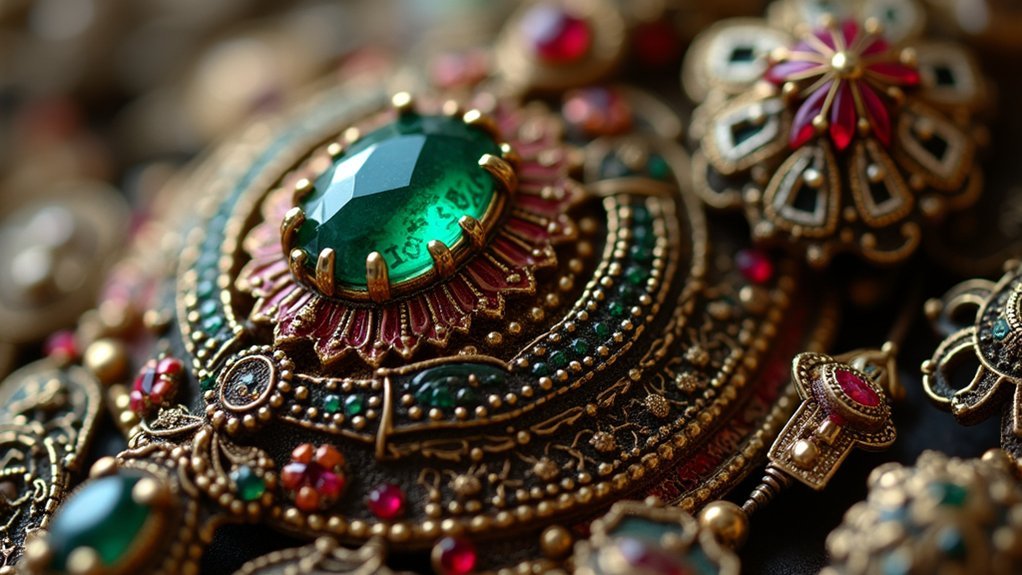
While modern jewelry often draws inspiration from contemporary designs, Victorian craftsmen looked to the distant past for their creative spark. The archaeological revival swept through the Victorian Era as discoveries from Egypt, Pompeii, and Greece fueled a fascination with antiquity.
You’ll find ancient civilizations represented in Victorian jewelry through scarabs, classical figures, and other historical motifs. Jewelers revived techniques like granulation and repoussé to create intricate designs that mimicked ancient craftsmanship.
Victorian jewelry honors antiquity through scarabs and classical motifs, reviving ancient techniques to create historically inspired masterpieces.
The period’s artisans skillfully adapted Etruscan gold work and traditional gemstone settings to produce pieces with historical significance. Cameos and intaglios became particularly fashionable, often set in elaborate gold frames that captured classical aesthetics.
This marriage of archaeological inspiration and Victorian craftsmanship created timeless pieces that continue to captivate collectors today.
Enameling Techniques and Their Cultural Significance
Alongside archaeological motifs, the Victorian era embraced the vibrant art of enameling to create jewelry that spoke volumes. When you examine Victorian pieces, you’ll notice how artisans fused powdered glass onto metal surfaces through heat, achieving durable, colorful designs that defined the period’s aesthetic.
The Victorians employed various techniques, including cloisonné with its distinctive wire outlines and champlevé with carved metal depressions. Each enamel color carried symbolic weight in sentimental jewelry—blue representing fidelity and green signifying hope.
This revival of ancient methods paired with innovative approaches transformed everyday items like brooches and lockets into vehicles for artistic expression.
Beyond beauty, enameling served practical purposes too, protecting the underlying metal while showcasing the exceptional craftsmanship that became synonymous with Victorian jewelry design.
Mass Production vs. Handcrafted Artistry in the Industrial Age

As technology transformed Victorian society, a profound tension emerged between traditional craftsmanship and industrial innovation in jewelry making.
The Victorian Era witnessed mass production techniques like electroplating and die-stamping revolutionizing the jewelry industry, making ornamental pieces accessible to middle-class consumers for the first time.
The industrial democratization of jewelry transformed Victorian society, allowing middle-class citizens to partake in once-exclusive personal adornment.
You’ll find that while machine-made jewelry flooded the market, handcrafted pieces maintained their prestige through superior techniques like repoussé, granulation, and intricate enameling.
These artisanal methods created unique works that couldn’t be replicated by factory processes.
New materials emerged too—vulcanized rubber and gutta-percha transformed mourning jewelry production, reflecting the era’s cultural sentiments.
Despite industrialization’s efficiency, the Victorian jewelry market ultimately supported both approaches, with handcrafted pieces commanding premium prices while mass-produced items democratized personal adornment.
Notable Victorian Jewelry Designers and Their Legacy
Masters of metal and gemstone, Victorian jewelry designers left an indelible mark on decorative arts through their innovative techniques and distinctive styles. Among the notable artisans, John Brogden’s exquisite goldsmithing and Samuel Johnson’s symbolic mourning pieces exemplify the era’s craftsmanship.
Charles Lewis Tiffany revolutionized the industry with luxury materials that continue to influence antique jewelry collectors today.
Augustus Frederick earned renown for his elaborate cameos, while Edward Spencer’s nature-inspired motifs captured Victorian fascination with the natural world.
These designers’ legacies persist in contemporary jewelry creation, their sentimental designs and intricate techniques inspiring modern artisans.
When examining antique Victorian pieces, you’ll recognize these masters’ distinctive styles—their meticulous attention to detail and innovative approaches transformed decorative arts forever.
Collecting and Authenticating Victorian Era Pieces
While reproductions flood today’s market, distinguishing authentic Victorian jewelry requires a trained eye and attention to subtle details.
When collecting Victorian pieces, examine them for signs of hand-craftsmanship—irregular patterns and intricate metalwork that machine-made reproductions can’t replicate.
Check for hallmarks, though their absence doesn’t necessarily indicate a fake, as many genuine pieces weren’t stamped.
Hallmarks offer valuable clues, but don’t dismiss unmarked pieces—authentic Victorian treasures often lack these identifying stamps.
You’ll want to study typical period motifs, such as mourning designs and popular gemstones like garnets and diamonds, to inform your collecting decisions.
Be wary of modern repairs that compromise a piece’s historical integrity.
For authenticating valuable Victorian jewelry, consult specialists familiar with period techniques. Their expertise can help you avoid costly mistakes and build a collection that faithfully represents this distinctive era of craftsmanship.
Frequently Asked Questions
What Are the Characteristics of Victorian Jewelry?
You’ll find Victorian jewelry features intricate designs with sentimental motifs like hearts and flowers. It’s crafted from gold and gemstones using techniques like repoussé and cannetille, often incorporating hair for personal mementos.
What Is the Difference Between Edwardian and Victorian Jewelry?
You’ll find Victorian jewelry (1837-1901) is heavier with gold and sentimental motifs, while Edwardian pieces (1901-1914) feature delicate platinum work with filigree and millegrain techniques for a lighter, more elegant appearance.
What Techniques Were Used in Medieval Jewelry Making?
In medieval jewelry making, you’ll find artisans used cloisonné, granulation, lost-wax casting, engraving, filigree, and niello techniques. They’d create intricate designs by setting gems in metal partitions and forming delicate metal patterns.
What Did Jewelry Look Like in the 1800S?
You’d see Victorian jewelry featuring romantic motifs like hearts and flowers. You’ll notice sentimental pieces made from 18k gold, adorned with diamonds and pearls, including large brooches, cameos, and mourning items.
In Summary
Victorian jewelry stands as a tribute to an era of refined craftsmanship and artistic innovation. As you explore these treasures, you’ll discover pieces that tell stories through their intricate techniques and symbolic designs. Whether you’re drawn to early gold work, delicate enameling, or gemstone innovations, today’s collectors aren’t just acquiring accessories—they’re preserving a remarkable chapter in jewelry’s evolution that continues to inspire contemporary designers.

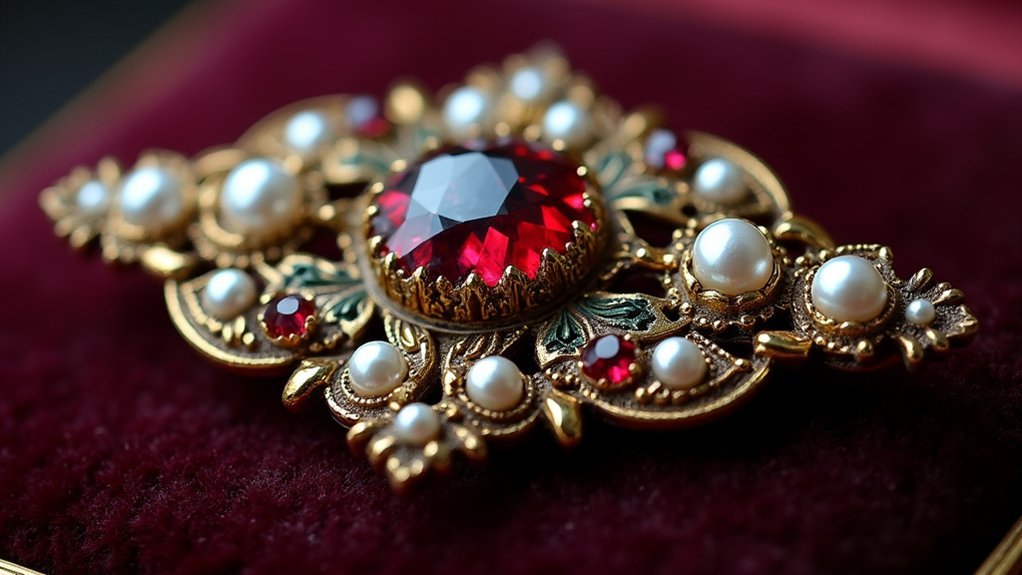
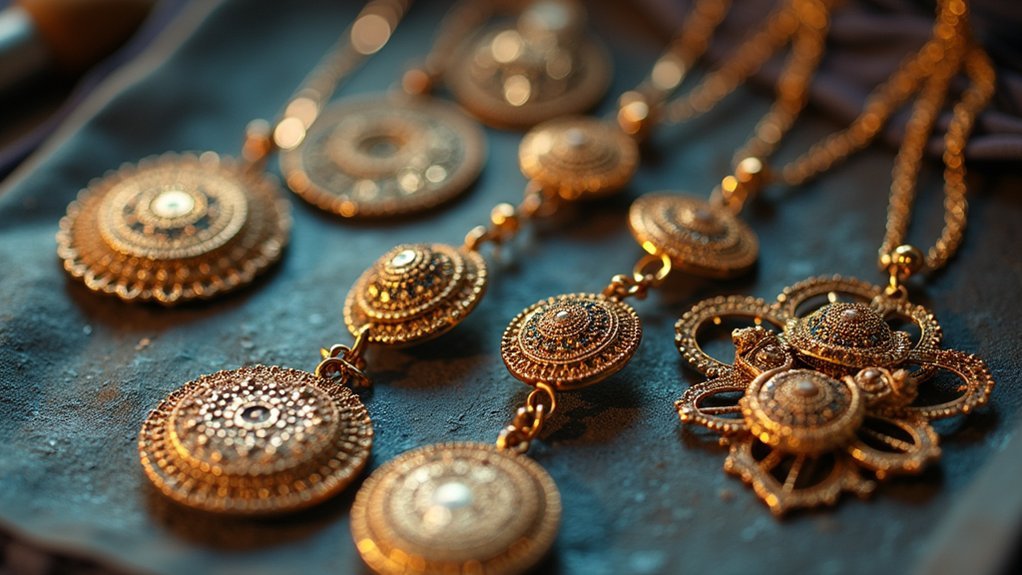
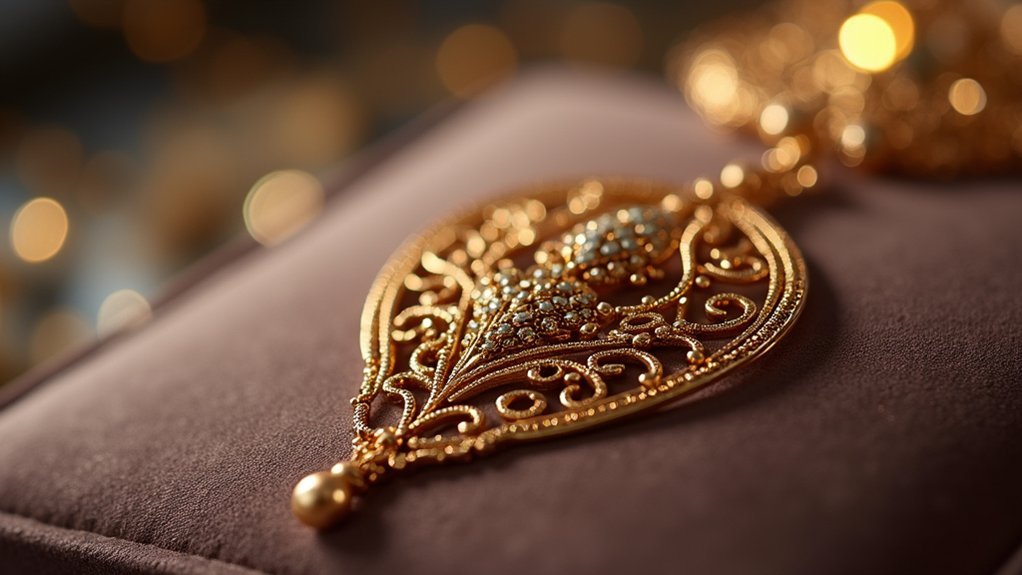

Leave a Reply